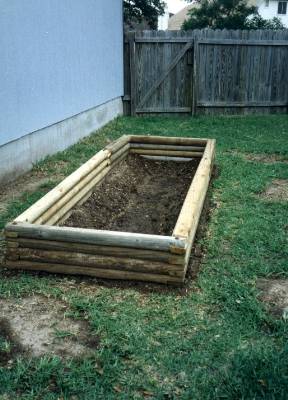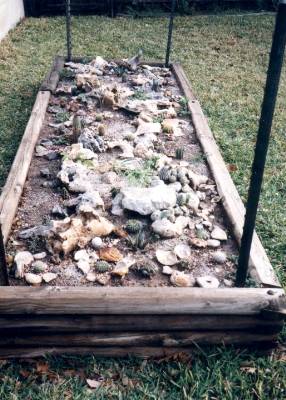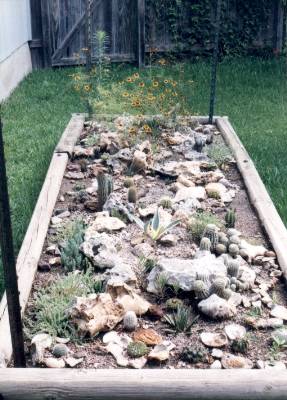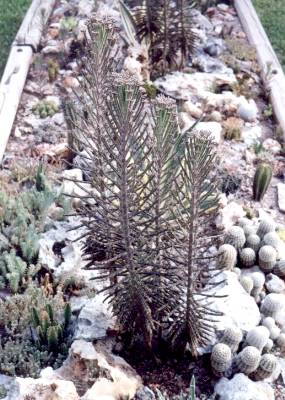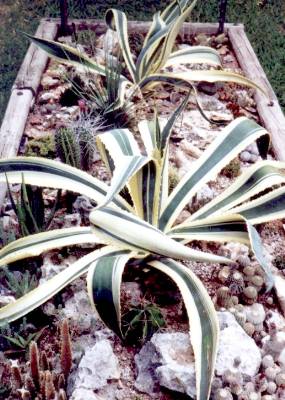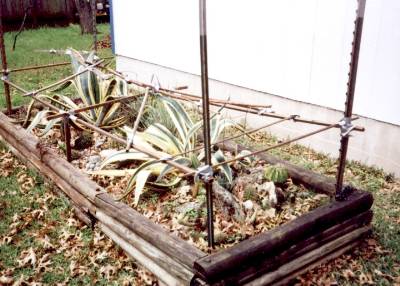Garden Gallery 3
Cactus Bed and Vine Garden
|
The raised bed garden was created in 1994 as a gift for Larry. This construction project was more involved than some and not only required the design and building of the walls but also some hefty rock removal.
Our dog, Frisky, was an eager participant in most landscaping activities. With her help, we were able to remove the large boulder pictured above and roll it about 20 feet to where it now serves as a garden seat.
The walls of this garden were constructed from 8-foot landscape timbers. The ends were cut to fit together. The short sides are 4 feet in length, while the long sides were made by pairing up 8- and 4-foot lengths. The logs are held together with six 13-inch long bolts with nuts on the bottom. These were found in a trash pile on one of our hikes. The garden was filled with a commercial mix of topsoil, sand and compost. Although the logs have warped and are rotting out in places, this garden is still quite functional nearly a decade later.
Taken around 1997, the above photo shows the cactus garden shortly after it was converted from a vegetable garden. The metal posts on the corners were installed to accommodate a protective frame and tarp during freezing temperatures. A number of interesting rocks were placed on top of the soil and the cactuses (obtained from nurseries, our relatives' property, and a few aged potted plants) were planted around them. The cactuses seemed to like their new home and some that had been potted for years bloomed for the first time
By 1998, the cactuses were growing slowly but steadily and annual wildflowers like coreopsis made use of the sunny, open area. While many succulents did well in their new home, a few could not take the heat and direct sun during the summer. Another cause of death among the plants was rot during rainy periods. When a cactus or other plant would die, it opened up a spot for something new. We never visited Wal-Mart or Home Depot without taking a quick look to see what they had in their cheapest little cactus inventory.
After a trip to Florida in 1998, we introduced some tiny kalanchoes that we found growing along the Atlantic coast into the cactus garden. In the above photo, taken the following year, these are the tall plants dominating the bed. In no time at all, the plants had grown two feet and were producing baby plants at an alarming rate. Because we never let the garden freeze (which would have killed them), they soon infiltrated all available spaces within the garden and surrounding lawn. It took months of careful weeding to remove most of them and allow only a few to grow under careful supervision.
Although hidden in the preceeding photo by the kalanchoes, a pair of small American agaves had been included in the original garden plantings. They did not grow very quickly at first, but, as can be seen in the above photo, by 2002 they had become the focal points. Because their leaves are rather slender, they do not prevent other plants from growing around them and we are simply cutting off the lowest leaves every so often in an attempt to keep them from becoming too large for their location. It may be a losing battle.
The above photo (taken in the spring of 2003) shows the temporary framework that we construct each winter. It is made of pieces of wood, a couple of wire plant supports, and lots of duct tape. When freezing weather is predicted, we cover the entire structure with a large tarp and use clothes pins to secure the corners. We have left this cover on for weeks at a time with no ill effects on the plants. In fact, we have never had a problem with any plants freezing in this garden.
We don't believe there is such a thing as a garden that is too narrow. The vine garden, pictured above when it was first created in 1995, was constructed by nailing pieces of wire fencing on the back side of a privacy fence. The base of the garden is bordered by landscape logs and only measures about a foot in depth.
The above photo shows the vine garden in 2003. The main plant that is visible is perennial morning glory, but trumpet vine is also evident in the middle section. There are several other different species that must fight it out with these plants, some of which have only begun their growth by the end of May.
|

